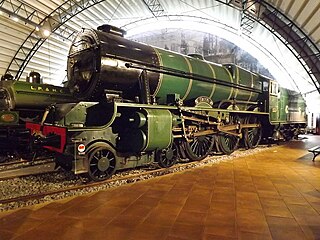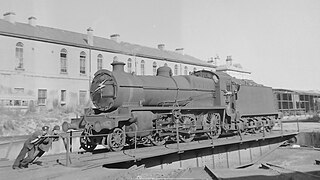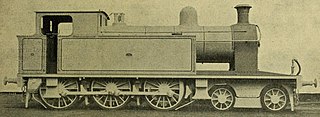Related Research Articles

The Great Southern Railways Company was an Irish company that from 1925 until 1945 owned and operated all railways that lay wholly within the Irish Free State.
A wide variety of steam locomotives have been used on Ireland's railways. This page lists most if not all those that have been used in the Republic of Ireland and Northern Ireland. Irish railways generally followed British practice in locomotive design.

Cork, Bandon and South Coast Railway (CB&SCR), was an Irish gauge railway in Ireland. It opened in 1849 as the Cork and Bandon Railway (C&BR), changed its name to Cork Bandon and South Coast Railway in 1888 and became part of the Great Southern Railway (GSR) in 1924.

The Great Southern Railways Class 800 steam locomotives were built principally for express passenger work on the Dublin to Cork main line of that company. These locomotives were designed under the supervision of E. C. Bredin with his Chief Draughtsman, H. J. A. Beaumont, preparing the drawings. They were the largest and most powerful engines ever to run in Ireland by quite a large margin, and the only three express passenger locomotives to be built in an independent Ireland.

The GS&WR Class 201 was a class of ten 0-6-0T locomotives designed by Locomotive Engineer, Henry Ivatt in 1887 for shunting heavy goods trains at Kingsbridge and Cork yards. Although the design is generally attributed to Ivatt they were actually created in the last year of Alexander McDonnell's tenure. The locomotives were built in three batch with variations between batches: Nos. 207—210 were introduced in 1887; 201 and 202 followed in 1895 taking numbers formerly held by Sambo and Negro; while the final batch 214—217 emerged in 1901.
The Tralee and Dingle Light Railway (TDLR) locomotives 1, 2, 3, 6, and 8 were 2-6-0T locomotives manufactured by the Hunslet Engine Company of Leeds, England between 1889 and 1910.

The Schull and Skibbereen Railway was a minor narrow gauge railway in County Cork, Ireland. It opened in 1886 and closed in 1947. The track gauge was a 3 ft narrow gauge. The formal name of the company was The West Carberry Tramways and Light Railways Company Ltd.

The Great Southern Railways Classes 372 and 393 were types of 2-6-0 ("mogul") steam locomotives exported to Ireland from Great Britain in 1924. They were designed by Richard Maunsell in 1914 for the South Eastern and Chatham Railway (SECR) to be members of the SECR N class of mixed-traffic engines. The GSR 372 and 393 classes were part of a batch of N and U class locomotive kits produced under a UK Government contract at the Royal Arsenal, Woolwich.

The CBSCR Bandon Tanks were a class of 4-6-0T mixed-traffic locomotives built for the Cork, Bandon & South Coast Railway (CB&SCR) between 1906 and 1920. The Bandon Tanks were the only 4–6–0 tank locomotives to be built by Beyer, Peacock & Company. The class went on to serve with the CB&SCR's successors: the Great Southern Railways from 1925 and CIÉ from 1945.

The Cork and Macroom Direct Railway (CMDR) was an Irish gauge railway in Ireland which ran the 24 miles (39 km) from Cork to Macroom.
The Timoleague and Courtmacsherry Railway was a 9 miles (14 km) long light railway connecting Timoleague station and Courtmacsherry station. It was the last roadside railway operating in Ireland.
The GS&WR 400 class or CIE class B2/B2a were a class of ten 4-6-0 steam locomotives built for the Great Southern & Western Railway (GS&WR) between 1916 and 1923 for express passenger duties on the Dublin to Cork main line. They proved initially unreliable but rebuilds from four to two cylinders between 1927 and 1937 for the seven survivors produced locomotives yielding satisfactory performance with the last two being withdrawn in 1961.

The Midland Great Western Railway (MGWR) A Class, later Inchicore Class D5, consisted of 6 4-4-0 express passenger locomotives built at Broadstone Works in the period 1902-1905. The largest express passenger locomotive in Ireland for a short while after introduction they were used on the MGWR's flagship services to Galway with most surviving until the 1950s albeit on less prestigious work.
The Great Southern Railways (GSR) 222/234 Classes 0-6-0 originated from 2 batches of 3 locomotives built for the Waterford, Limerick and Western Railway (WLWR) by Kitson with a contract payment dispute resulting in the final two members going to Midland Great Western Railway becoming MGWR Class W.
The Great Southern Railways (GSR) Class 280 were 0-4-0T locomotives built by Sentinel in 1927.
The Great Southern and Western Railway (GS&WR) Class 341 consisted of a single 4-4-0 express passenger locomotive named Sir William Goulding introduced in 1913 for the Dublin—Cork route. Despite being an apparently capable design it was withdrawn in 1928.

The Great Southern and Western Railway (GS&WR) Class 47 consisted of twenty 0-4-4BT locomotives designed by Alexander McDonnell and introduced from 1883. They were intended for branch lines around Cork and for Dublin—Kildare and Dublin-Kilkenny services.
The Great Southern and Western Railway (GS&WR) Class 900 consisted of a pair of 4-8-0T locomotives designed by E.A. Watson and introduced in 1915 and 1924 as a heavy shunter and banker for use on the relatively severe gradient from Kingsbridge to Clondalkin.

The GS&WR) Class 33 consisted of six 2-4-2T locomotives designed by Henry Ivatt for Kerry branch line services, especially tight radius curves of the branches to Kenmare and Valencia.
The (GS&WR) 0-6-4T were a set of 6 locomotives of two variants of the 0-6-4T arrangement designed by Alexander McDonnell. When introduced in 1876 it was the first use of a 0-6-4 configuration in the British Isles. The final four locomotives were to be designated GS&WR Class 203.
References
- 1 2 Clements, Jeremy; McMahon, Michael (2008). Locomotives of the GSR. Colourpoint Books. ISBN 9781906578268.